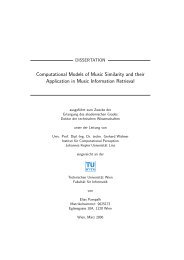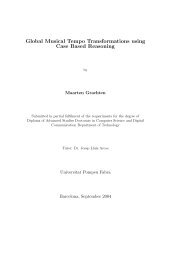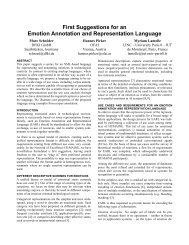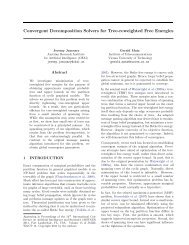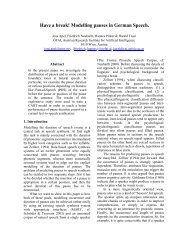A HYBRID MODEL OF REASONING BY ANALOGY
A HYBRID MODEL OF REASONING BY ANALOGY
A HYBRID MODEL OF REASONING BY ANALOGY
You also want an ePaper? Increase the reach of your titles
YUMPU automatically turns print PDFs into web optimized ePapers that Google loves.
system is getting in the state depicted on figure 13 - 1b. Starting from this state the associative<br />
mechanism brings G2 in the focus and a second parallel mapping is started between<br />
G4 and G2 (the current transfer process continues to build a new slot of G4 - slot9: G409 <br />
- corresponding to slot3 of G1).<br />
In short, the result of this second mapping is the following correspondence:<br />
G2.slot1 - G4.slot1<br />
G2.slot2 - G4.slot2<br />
G2.slot4 - G4.slot3<br />
G2.slot6 - G4.slot4<br />
G2.slot8 - G4.slot5<br />
G2.slot9 - G4.slot6<br />
G2.slot12 - G4.slot7<br />
G2.slot13 - G4.slot8<br />
G2.slot3 - G4.slot9,<br />
the transfer process builds correspondences to slot5, slot7, slot10 and slot11 of G2 and in this way<br />
G4 becomes an instantiation of G2, i.e. the reasoning process has switched to a deductive one.<br />
The evaluation process detects an inconsistency between G2.slot9 and G4.slot6<br />
and reports that in this way the water cannot be heated, i.e. in the end the system fails<br />
to solve the target problem.<br />
2) In the second experiment , a set of concepts (immersion_heater, water, hot, etc.) are presented<br />
to the system for a definite period of time before the target problem is given. As a result the system<br />
starts the reasoning process in the state described in figure 13 - 2a.<br />
Starting from this memory state, the associative mechanism brings the description G3, i.e.<br />
situation C, in the focus. A mapping between G3 and G4 starts which results in the following<br />
correspondences:<br />
G3.slot1 - G4.slot1<br />
G3.slot2 - G4.slot2<br />
G3.slot4 - G4.slot3<br />
G3.slot6 - G4.slot4<br />
G3.slot8 - G4.slot5<br />
G3.slot9 - G4.slot6<br />
G3.slot10 - G4.slot7<br />
G3.slot11 - G4.slot8<br />
At this point the transfer process starts to seek a correspondence to the immersion heater. It puts<br />
immersion heater, hot and in on the goal list and waits for the result of the associative mechanism.<br />
Actually, there is nothing very close to these constraints in the memory of the system, so the result<br />
of this retrieval will depend more on the overall state of the memory than on this specific cue. Since<br />
the concept of a knife is on the input list (with relatively high activity) and it receives additional<br />
activity from immersion heater (via the object node) and from in (because a knife, being small, can<br />
be put in other objects), it eventually becomes the focus. The evaluation process starts a marker<br />
passing for knife and hot and detects a path through a heating plan (the knife itself has to be heated<br />
in the fire). So, now the transfer process constructs an additional slot - slot9: - in G4, and<br />
transfers the slots for hot (slot7) and for the relation in (slot5) from G3 to G4. In this way a<br />
complete correspondence between G3 and G4 is established and the target problem is solved.




